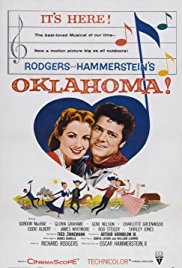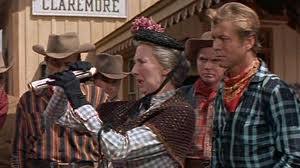OKLAHOMA!
SUBJECTS — Drama/Musicals; U.S./1865 – 1913 & Oklahoma; Dance/Performance;
SOCIAL-EMOTIONAL LEARNING — Romantic Relationships;
MORAL-ETHICAL EMPHASIS — Responsibility.
AGE: 12+; No MPAA Rating;
Musical; 1955, 145 minutes; Color.
There is NO AI content on this website. All content on TeachWithMovies.org has been written by human beings.

SUBJECTS — Drama/Musicals; U.S./1865 – 1913 & Oklahoma; Dance/Performance;
SOCIAL-EMOTIONAL LEARNING — Romantic Relationships;
MORAL-ETHICAL EMPHASIS — Responsibility.
AGE: 12+; No MPAA Rating;
Musical; 1955, 145 minutes; Color.
TWM offers the following worksheets to keep students’ minds on the movie and direct them to the lessons that can be learned from the film.
Film Study Worksheet for ELA Classes and
Worksheet for Cinematic and Theatrical Elements and Their Effects.
Teachers can modify the movie worksheets to fit the needs of each class. See also TWM’s Movies as Literature Homework Project.
Rogers and Hammerstein outdid themselves with this musical about courting in the Oklahoma Territory just before it became a state (1907). Three generations have adored “Oklahoma!” The story is based on the play “Green Grow the Lilacs” by Lynn Riggs.
Selected Awards:
1955 Academy Awards: Best Sound, Best Score; 1955 Academy Awards Nominations: Best Color Cinematography, Best Film Editing. This film is listed in the National Film Registry of the U.S. Library of Congress as a “culturally, historically or aesthetically significant” film.
Featured Actors:
Gordon MacCrae, Shirley Jones, Rod Steiger, Gloria Grahame, Eddie Albert, Charlotte Greenwood, James Whitmore, Gene Nelson, Barbary Lawrence, Jay C. Flippen.
Director:
Fred Zinnemann.
Music:
Richard Rogers.
Lyrics:
Oscar Hammerstein, II.

This classic is superbly sung, superbly acted, and superbly danced. It is the setting for beautiful songs such as: “Oh What a Beautiful Mornin,” “People Will Say We’re In Love,” “The Surrey with the Fringe on Top,” “I Cain’t Say No,” “Kansas City,” and “The Farmer and the Cowman.” The dance accompanying “Kansas City” evokes the spirit of the frontier Western U.S. better than any dance on film.
“Oklahoma!” describes a United States of innocence, youth and vitality whose problems were manageable and did not threaten the fabric of society. The song “Kansas City” expresses the wonder of rural people at the inventions that transformed life at the turn of the 20th century.
None.
Before watching the film, briefly tell your child about the Oklahoma Territory. See Helpful Background. Immediately after the movie, or at odd times over the next week (for example at the dinner table or in the car on the way to school) bring up some of the Discussion Questions, starting with the Quick Discussion Question in the sidebar. Don’t worry if you can only get through a few questions. Just taking the film seriously and discussing it is the key. Allow your child to watch the movie several times and continue to bring up discussion questions relating to the film.
As the U.S. added Western territories, they were administered by the Federal Government. For example, the marshal who arrests Curly is a federal official. The territories would petition to be admitted to the Union as states. Oklahoma territory became the 46th state in 1907. This movie takes place just before that time. Will Parker has just been to Kansas City. He remarks, in the song, about how “Everythin’s up to date in Kansas City.” This song tells a lot about what is happening in the U.S. at the time of this movie:
“They went and built a sky scraper seven stories high. About as high as a buildin’ orta grow.”
Until the perfection of the elevator in the 1890s, seven stories was about as high as a building could go. Most people can’t climb more than seven flights of stairs at one time. The first skyscraper was built in 1895 (Louis Sullivan’s Guaranty Building, Buffalo, N.Y.) It took time for real skyscrapers to be built in Oklahoma.
“I counted 20 gas buggies goin’ by theirselves, almost ev’ry time I tuck a walk.”
The automobile was becoming common in the first decade of the 20th century. According to the song, there were very few in rural Oklahoma.
“[Then] I put my ear to a Bell telephone and a strange woman started in to talk.”
The telephone was invented by Alexander Graham Bell in 1879 but, apparently, had not made it to rural Oklahoma by the time of this song.
“Y’ c’n turn the radiator on whenever you want some heat. With ev’ry kind o’ comfort ev’ry house is all complete. You c’n walk to privies in the rain and never wet your feet! They’ve gone about as fur as they c’n go.”
Indoor plumbing was rare in rural areas of the Territory of Oklahoma.
In the frontier areas, peddlers brought goods to the farmers. They were often distrusted by the farmers, especially when the peddlers were recent immigrants.
In the states on the Great Plains there was tension between ranchers who needed free unfenced range to run their cattle and farmers who erected fences to protect their crops from wandering animals.
1. See Discussion Questions for Use With any Film that is a Work of Fiction.
2. What was the source of tension between the farmers and the cowboys?
3. Why was fire such a dangerous weapon of revenge at the time of this story? (Read Faulkner’s short story “Barnburners.”)
1. See the Quick Discussion Question.
Discussion Questions Relating to Ethical Issues will facilitate the use of this film to teach ethical principles and critical viewing. Additional questions are set out below.
(Treat others with respect; follow the Golden Rule; Be tolerant of differences; Use good manners, not bad language; Be considerate of the feelings of others; Don’t threaten, hit or hurt anyone; Deal peacefully with anger, insults, and disagreements)
This Learning Guide was last updated on December 17, 2009.